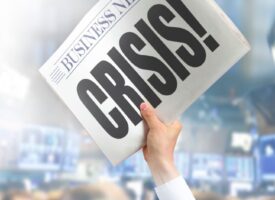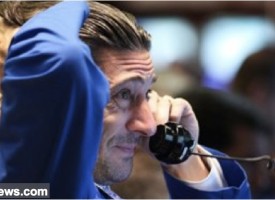As we come to the end of 2016, in what has been an extremely tough environment in the gold and silver markets, below is an important look at the big picture as we head into 2017.
By Trey Reik, Sprott Asset Management
December 30 (King World News) – Financial markets have experienced pronounced volatility during the six weeks since Donald Trump’s surprising presidential triumph. Given overwhelming pre-election consensus for a Clinton victory, coupled with near unanimous forecasts for a stock-market rout in the event of a Trump win, we would have expected market participants to be somewhat chagrined by the election outcome. Of course, in the “everything is great” contemporary financial era, exactly the opposite has occurred—investors appear enthralled with the potential for a still-gelling Trump administration to cure the world’s lingering economic ills. Nowhere has this spontaneous optimism been more apparent than in U.S. equity markets. After more than tripling from March 2009 lows, under the stewardship of the Obama administration and a Bernanke/Yellen Fed, the S&P 500 has now sizzled to fresh highs, apparently comforted by Trump’s unequivocal repudiation of the cornerstone policies on which the Obama/Bernanke/Yellen era was based…
Sponsored
To hear what billionaire Eric Sprott & Rick Rule are doing with their own
money and which $7 billion company John Embry &
Dr. Marc Faber oversee click on the logo:

While the aggregate value of U.S. equities (as measured by the Russell 3000) has soared $1.50 trillion since election night (6.35%-gain through 12/16), the performance of the Dow Jones Industrial Average has been even more inspiring. Powered by a 31.33% advance in American corporate icon Goldman Sachs, the Dow has advanced 8.24% since election night (through 12/16). Indeed, during the week of 12/5, the Dow set five consecutive (Monday through Friday) closing all-time highs for the first time since April 1999. What is motivating such unbridled, post-election enthusiasm for such a scorned, pre-election pariah? Obviously, contagious enthusiasm is spreading among investors that Trump’s vague recipe of tax cuts, fiscal stimulus, Obamacare repeal, reinvigoration of domestic manufacturing, repudiation of China, and, above all else, “strong borders,” might actually do the trick in returning the U.S. economy to escape-velocity performance.
If nothing else, President-elect Trump has already catalyzed a clear uptick in both consumer and business sentiment. The University of Michigan consumer sentiment index jumped to 98.0 in December from 93.8 in November (and 87.2 in October). On the business side, the NFIB small business sentiment index climbed to 98.4 in November from its prior-month reading of 94.9, the steepest monthly increase since April 2009. Even the NAHB Housing Market Index erupted to a reading of 70, the highest since July 2005. Coupled with the Fed’s temerity to proceed with its second 25-basis-point rate hike in ten-and-one-half years, optimism over Trumponomics has empowered a sparkling post-election performance for the U.S dollar. From an (11/8) overnight low of 95.89, the DXY Dollar Index rallied 7.37% to its 12/16 close of 102.95, its highest level since January 2003.
Unfortunately, investor enthusiasm over Trump’s pro-growth agenda has been so invigorating that it has even awakened somnambulant bond vigilantes. Grouchy from their long slumber, bond bears have quickly clawed out one of the bloodiest stretches in fixed-income history. During November, the Bloomberg Barclays Global Aggregate Total Return Index (launched 1990) posted its worst-ever month, shedding 4% of total capitalization and declining $1.7 trillion to a month-end valuation of $45.1 trillion. Here in the U.S., 10-year Treasury yields have soared 51% from an election-night low of 1.71%, to a 12/16 close of 2.59%. Not only have yields of all ilk broken sharply higher, expectations for more of the same now dominate 2017 forecasts. A December 2016 BAML survey (of global fund managers) revealed that a near-unanimous 94% of professional investors expect bond yields to rise during the next twelve months.
All-in-all, the post-election performance-divergence between stocks and bonds has reached fairly extreme proportions in a very compressed period of time. As demonstrated in Figure 1, below, zero-sum capital migration from bond-to-stock markets is approaching $3 trillion. While there is no ironclad guarantee this performance cannot continue, history certainly favors resolution in one direction or the other in fairly short order. Equity investors are favoring prospects for growth unimpeded by excessive inflation or concerns for Fed policy being behind the curve. Bond investors appear troubled that policies of the incoming administration pose inflationary risks (and likelihood for a more hawkish Fed) which were improperly priced in pre-election rate structures. Something has to give! In our mind, the current separation between stock and bond sentiment is potentially reminiscent of experiences in 1987 and 1999, in which 50% backups in yields did not initially trouble the stock market, until they finally did. An added similarity to the 1987 investment landscape is the contemporary bevy of investment-product innovations (ETF’s, risk parity, algorithms) which have yet to be tested by conditions of true market stress.

What have post-election market developments meant for the gold investment thesis? Logically, the combination of high asset valuations, domestic political shock, increasing probabilities for expanding budget and trade deficits and mounting concern over incipient inflationary pressures sounds like a pretty supportive climate for gold sentiment. Throw in the predicative history of sharp bond selloffs in telegraphing future turbulence in equity markets, and gold might be expected to enjoy a firm bid. As can often be the case in gold markets, however, we believe short-term, kneejerk associations have dominated recent trading in the gold complex, causing market participants to miss the forest through the trees. Perhaps most attributable to recent dollar strength, spot gold through its 12/16 close of $1,134.84 had declined 15.15% from its election-night high of $1,337.51. Similarly, the Sprott Gold Miners ETF (SGDM) declined 26.43% from its 11/9 opening high of $23.50 to its 12/16 close of $17.29, and the Sprott Junior Gold Miners ETF (SGDJ) declined 28.01% from its 11/9 high of $40.55 to its 12/16 close of $29.19.
In regards to the incoming U.S. presidential administration—Trump’s election holds extremely limited relevance to the gold thesis in our opinion. Domestic and global debt levels only continue to expand (far past any reasonable relation to underlying productive output). Monetary debasement by global central banks continues to run at fever pitch (BOE, BOJ and ECB combined QE now $185 billion per month). The Fed itself still feels compelled to purchase $50 billion of securities each month to keep its balance sheet flat. Trump’s campaign-promises for lower taxes and fiscal stimulus, if enacted, will take time to legislate, will certainly worsen the U.S. current account in the short-run, and will ultimately take many years to affect potential positive impacts. Along the way, mounting global imbalances only increase probabilities for a financial dislocation in coming periods.
To us, the greatest mystery in recent movements in financial markets is the overwhelming consensus that interest rates can rise and the U.S. dollar can strengthen without serious harm to the global financial system. If the Fed has felt unable to raise rates for eight years, what financial and market conditions in 2017 will allow them to finally do so? If the Fed’s December 2015 liftoff and confident forecast for four 2016 rate hikes led to an eruption of financial market stress in early 2016, why will 2017 prove any different (debt levels are higher everywhere today than this past year)? Since every 100 basis point increase in market rates causes total interest charges in the U.S. to soar $470 billion (1% x U.S. nonfinancial credit of $47 trillion—Fed’s Z.1) or over 2.5% of GDP, why does consensus now believe rates can suddenly rise without causing severe damage to the U.S. economy?
We present in Figure 2, below, the ever unpopular truism that excessive U.S. debt levels have capped cyclical highs for 10-year Treasury yields at progressively lower levels since 1981. With total U.S credit market debt now totaling $65.7 trillion, up $3 trillion in the past 12 months, and up $16.9 trillion since the Fed’s year-end 2007 calculation, no amount of Trump bravado (or corporate animal spirits) will support rising long-rates until excessive debts in the United States are “rationalized.” When one throws in a triple in aggregate equity valuations (claims) since 2009, as well as a coincident 42% increase in household real estate values, we are pretty confident that the U.S. financial system is in no position to endure even modest upticks in long-rates without significant dislocations to financial asset prices and a sharp spike in default rates.
10-Year Treasury Yield

Similarly, with $10 trillion in offshore debt now denominated in U.S. dollars, we find it virtually impossible for the U.S. dollar to strengthen meaningfully without catalyzing significant global financial stress. Given the late-stage Triffin-dilemma quandaries faced by the U.S. dollar, we believe any sustained dollar strength will trigger destabilizing global capital flows (away from emerging markets). Quite simply, the dollar’s recent strength is already causing significant contraction in global money supply. Andy Lees (MacroStrategy Partnership) calculates that World Money Supply has contracted $3.634 trillion from its 9/30/16 peak, a 3-month-annualized rate of contraction equaling -13.94%.

Needless to say, we view global liquidity as already insufficient to support reigning financial asset prices. In our view, the dollar will need to weaken and the Fed will need to provide further liquidity programs in 2017 to address contraction in global money supply. We present in Figure 3, below, the prior peaks in dollar strength at which the Fed felt compelled to address global liquidity needs with QE1, QE2 and QE3. Face-saving rate hikes these past two Decembers aside (to separate from the zero bound), we would suggest further rate hikes (and subsequent dollar strength) are simply not in the cards anytime soon.

We will be utilizing the relative calm of the holiday season to complete work on our overdue update on the comprehensive investment case for gold in 2017. In this report, we will provide our answers to the suppositional questions posed above. We look forward to publishing this piece during the week of January 9.
Until then, best wishes for a happy holiday season.
***ALSO JUST RELEASED: ALERT: Major End Of The Year Update On The Gold Market CLICK HERE.
© 2015 by King World News®. All Rights Reserved. This material may not be published, broadcast, rewritten, or redistributed. However, linking directly to the articles is permitted and encouraged.







